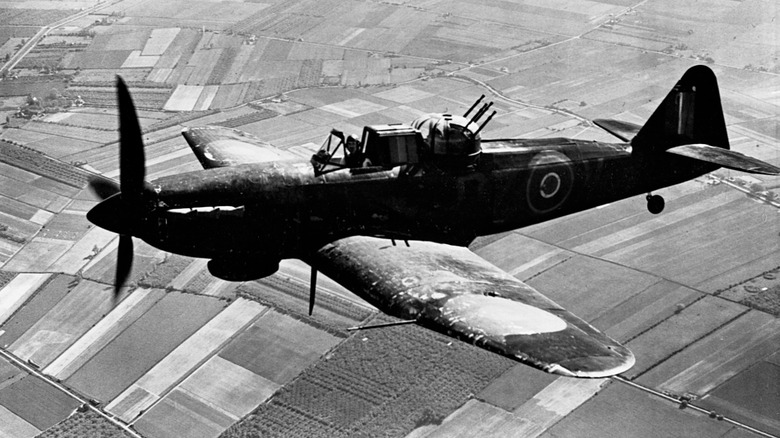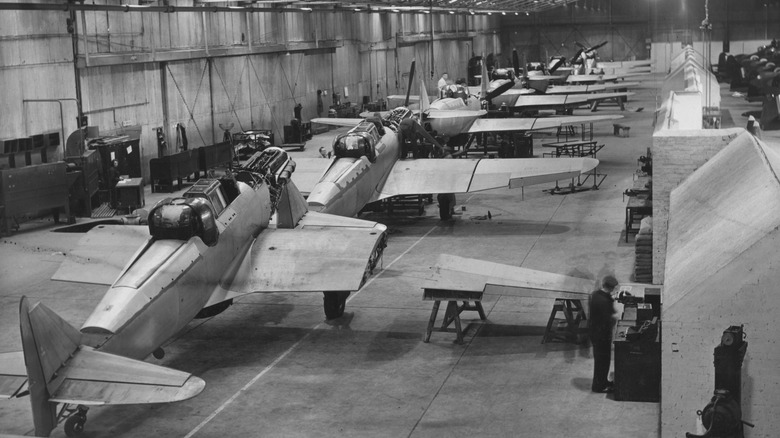Why The Boulton Paul Defiant Is Such A Controversial WW2 Aircraft
Around the same time that Fiat was constructing wooden dogfighting biplanes to send into battle, and the Germans were building overly simplistic jet-powered bomber hunters for teenagers to fly, the British were making legendary planes like the Hawker Hurricane and Supermarine Spitfire. That's not to say the Brits didn't produce some dubious flying flops, though.
The Boulton Paul Defiant was a twin-seat fighter plane whose sole objective was to bring down German bombers. Behind the pilot sat a gunner operating a swing turret with a 360-degree upper hemisphere field of fire. The plane was to fly underneath unescorted bomber formations and attack them at their weakest point with its four .303 caliber machine guns.
The strategy seemed sound, but today, this British fighter more often turns up the worst planes from World War II lists. While it did notch some admirable achievements, it's typically thought of as a good idea that just wasn't executed properly. The Defiant was initially designed to be a day fighter by Boulton Paul Aircraft and was hurried into service to bolster the Royal Air Force's squadrons of Hurricanes and Spitfires, which weren't being produced in the numbers the RAF were expecting.
The element of surprise was on the Defiant's side when it first took to the skies with Squadron 264 during Operation Dynamo at the end of May 1940. Along with Spitfires and Hurricanes, it provided air support while over 330,000 French and British soldiers evacuated the French port of Dunkirk.
The undcover bomber hunter
The German Luftwaffe pilots mistook the Defiants and attacked in their Messerschmitt Bf 109s from above and behind, thinking they were Hurricanes armed with forward-facing guns. They were wrong. Over the next few days, the Defiants shot down six Bf 109s, a Junkers Ju 87 Stuka bomber, its Messerschmitt Bf 110 escort, a Heinkel He 111, and damaged two other 111s — all in all, a job well done.
Then it went into the Battle of Britain on July 19, 1940, with the No. 141 Squadron, and by then, the Luftwaffe pilots had gotten wise to the fact that the Defiant had no front armaments. Six of the nine aircraft in the squad were lost, along with the lives of ten airmen. That was its last daytime sortie. The RAF quickly converted it into a night fighter, thinking the cover of darkness would allow the plane to more easily sneak underneath bombers and execute its intended mission with less risk.
The Defiant was armed with four .303 Browning belt-fed machine guns capable of firing 600 rounds of ammunition. Powered by a Rolls-Royce Merlin engine, it was able to reach speeds north of 300 mph, but the combined weight of the guns (88 pounds), ammunition (106 pounds), and the removable hydraulic turret (361 pounds) added more than 550 pounds to the plane. Moreover, the drag from the turret's bulbous dome jutting above the pilot canopy diminished its speed and maneuverability.
Defiant to the end
Despite its flaws, the RAF continued to tweak the Defiant. It was outfitted with a top-secret AI Mk IV (Airborne Interception, Mark IV), the first mass-produced air-to-air radar system. During the winter of 1940 into 1941, it immediately became integral to England's defense against German bombing raids and chalked up more enemy kills than any other night fighter.
At the time, the Nazi network of overlapping early warning radars known as Freya was causing untold havoc because it could "see" aircraft as far as 100 miles away. The RAF desperately needed something to circumvent it.
"Moonshine" was a trick developed to "spoof" Freya into seeing more planes than were actually in the sky. Aircraft equipped with a transmitter flew out to designated coordinates, intercepted and amplified radar pulses, and created bogus hits. The second method was "Mandrel," which also required aircraft fitted with a radio transmitter to fly in a screen-like formation and create a 200-mile wide gap in radar coverage. This allowed as many bombers as needed to pass through unseen.
The Boulton Paul Defiant was used to carry out several successful sorties using both methods and thus became the first plane outfitted with electronic countermeasure systems (ECM). On July 17, 1943, its last operational mission was in this ECM role. Other versions were turned into target tugs, used to airdrop dinghies on rescue missions or test the first ejection seats.
Production ended in February 1943, with 1,064 being built. Despite early limitations as a niche weapon, the RAF finally found roles for which the Defiant was suited and finished out its career admirably.

